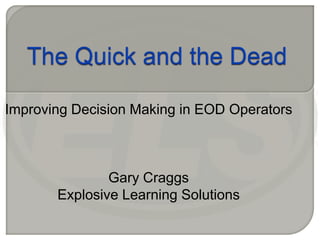
The Quick & The Dead
- 1. The Quick and the Dead Improving Decision Making in EOD Operators Gary Craggs Explosive Learning Solutions
- 2. Decisions, Decisions… Successful ops depend on making the right decision at the right time So it’s important we teach people how to make the right decisions But how good are we at doing that?
- 3. Traditional Decision Making Rational, analytical, models Typically, options are formed and evaluated Often taught in management leadership development programmes Good for stable environments but…..
- 4. ……...they do not reflect how people actually make critical decisions under pressure
- 5. Move to Naturalistic Decision Making US Army recognised this They had invested heavily in decision making training but achieved poor ROI 1984 US DoD research call won by Gary Klein Studied “in the field” rather than in the lab Fire fighting commanders Naval officers Nurses Developed concept of “Naturalistic Decision Making
- 6. NDM Settings Time pressure High stakes Experienced decision makers Inadequate information Dynamic conditions Team co-ordination
- 7. Klein's Findings People did not compare options – many felt they didn’t make “decisions” They chose the first workable option based on their assessment of situation People rarely used analogous situations – they used a blend of situations They improved their options by imagining implementation
- 8. Recognition Primed Decision Making Process Decision maker picks up cues that let them recognise patterns Based on these patterns they choose a single course of action (action script)they consider will achieve the outcome The decision maker runs the action script through a mental simulation based on mental models developed through experience Action script is assessed against what is known to work and improved if necessary
- 9. Recognition Primed Decision Making Requirements Expertise Situational awareness Spotting patterns and anomalies Knowing limitations Intuition Implicit learning not ESP Identifying cues
- 10. Recognition Primed Decision Making Requirements Mental Simulation Ability to imagine and transform images Too simple or too complex it doesn’t work 3-6 transitions Storytelling Helps the teller understand Helps the novice gain expertise
- 11. EOD Op Training Tends to focus on: Skills Equipment handling Information gathering Co-ordination Application of Procedures Decision making is tested rather than taught
- 12. Embedding RPDM in Training Expertise Identify and train-in patterns Develop situational awareness through activity/media rich scenarios Intuition Identify and train-in cues
- 13. Embedding RPDM in Training Mental Simulation Encourage imagination Cognitive walk through exercises Storytelling Trainer mentors Warts and all presentations Actual individuals not actors
- 14. Conclusions Rational decision making models do not work in pressure situations RPDM is how people actually do make decisions in high pressure situations Techniques for employing and improving RPDM can be taught